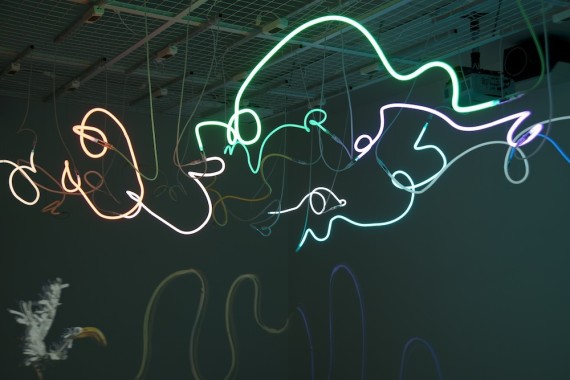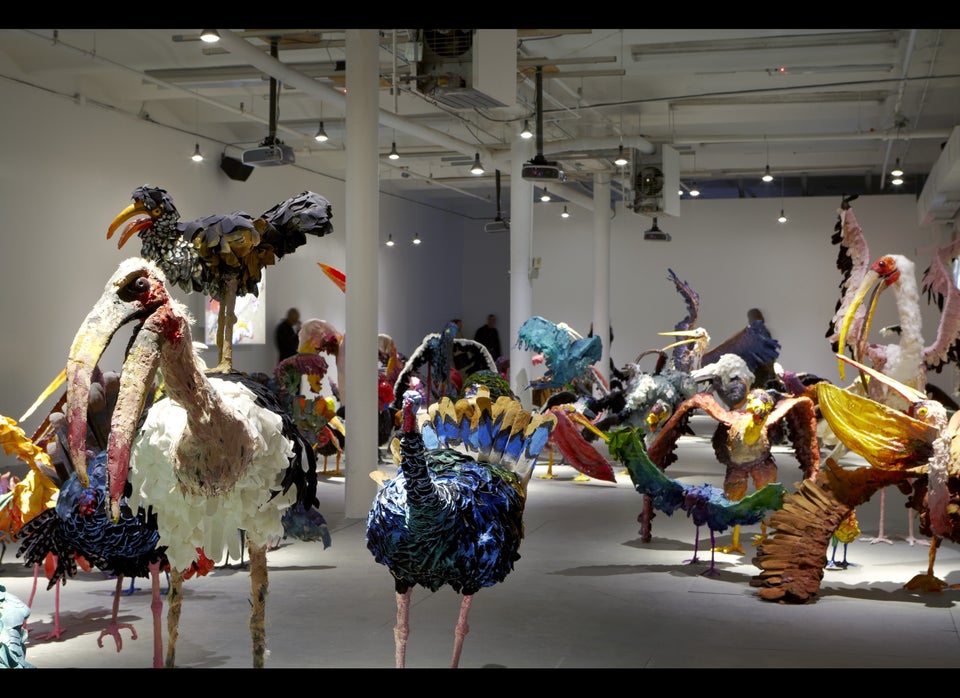Together, Swedish artist Nathalie Djurberg and Swedish composer Hans Berg create visceral multi-sensory experiences that mimic the giddy thrill of eating endless sugar, followed by the unsettling sensation that results. They're primarily known for their grotesque claymation animations that clump together childish whims and animal desires, making blood and guts look like craft materials ripe for squeezing.
Their newest exhibition, titled "The Gates of the Festival," envelops the viewer in one massive, immersive installation that weaves its way throughout the entirety of London's Lisson Gallery. The show explores the wily relationship between sight and sound, the moments they converge and separate again.

In one piece, entitled "Gas, Solid, Liquid," the viewer confronts 10 waist-high urns, each containing within its ceramic confines a unique work of animation and musical accompaniment that vibrates from the urns' bellies. In "Fever Dreams," a musical soundtrack combines with light projections to transform white tables into performing sculptures, their tabletops become "impregnated and enlivened by flowing depictions of amoebic organisms, malleable matter and clouds liquefying back to rain and seawater." These two bodies of work toy with the idea of a womblike environment to mimic the cycle of life.
The main aspect of the installation, "The Gates of the Festival," features 12 neon shapes hung from the ceiling, each illuminated and animated according to a musical soundtrack provided by Berg. Each tone or frequency choreographs the shape in a different way, in effect "playing" the art piece like a musical instrument. Just to make certain the piece is sufficiently strange, abstract animations will adorn the walls, along with the rotating image of a wiry claymation bird.
Djurberg and Berg explore the dark and sticky urges that flow between your brains and your belly in electric colors and ambient sounds. Their psychological explorations begin as suspiciously cute before molting into something infinitely darker right before your eyes (and ears). We reached out to the artists via email to learn more about their newest exhibition:

Both nature and childhood often have the popular impression of being pure, idyllic and innocent, though in both cases you capture the dark underbelly of these states of being. Do you see a connection between nature and childhood in the ways they are perceived or perhaps misunderstood?
Nathalie Djurberg and Hans Berg: Yes, before culture comes in. The child starts out pure but then is corrupted with all the conditioning that it endures –- although this is necessary to develop a sense of the self. Hopefully, later in life you can grow, loosen up from the conditioning and break away from that. We look through the eyes of culture and so we see the cruel, dark aspects as bad, but that is just part of it.
What inspired you to explore the darker aspects of nature in this exhibition? What, if any, correlation are you making between the natural world and the womb?
ND & HB: Sure, we can see that. It could be about the womb, as that is a nice interpretation, after all we believe that art doesn’t belong to the artists once it leaves the studio. But it’s certainly about inner space, rather than outer space. The show is also about entering the not-knowing and not putting a label on an experience, it’s about investigating your experiences in different ways. While making the animations for all the pots, it was about the complete fascination of how these still drawings can create the illusion of a material. Those 10 alone took around six or seven months to make.
This exhibition is filled with animated elements, and yet no traditional screens. What inspired you to use such unconventional spaces for your animations to inhabit?
ND & HB: Some of the projections, for the installation entitled "Fever Dreams," for example, are indeed on the surface of four tables, which are sculptures. You look down on them and perceive them as solid surfaces, but if you were to go into them it would be just atoms and space. But on top of them are the projections that move constantly, fall apart, never staying the same. I am interested in that idea of not having something to hold on to but if you relax into it there is a fascination with this change of perspective.
Why create the show as one continuous artwork?
ND & HB: Because that is the interest, just exploring something from different angles until it’s not interesting anymore or you give up because you didn’t find the answer, which you don’t really do in art, it’s not about the answer it’s about the question. So it solved itself in that way, it’s just a different aspect of reality or non-reality. There is a linking device, in so far as there is music everywhere in the show. There are 16 soundtracks that work well together but there is no single narrative or storytelling, there is no timeline. Instead everything is looped and circuitous and that puts you out of time –- you don’t have to stay until the end or wait for the beginning. It’s a continuum within each work and between each work –- they are all connected.
Your installations in the past have reminded me of children's cartoons or theme park rides gone awry. Are you interested in the media and experiences often digested by young people and toying with those forms?
ND & HB: Not really, it’s just a medium we used. It suited me for what I wanted to do and felt interesting and in the previous cases with stop-motion and narrative-led animations it’s just the perfect solution: you don’t have to work with actors, you are playing god, you have full control over your own world. People look at it in unexpected ways, because they think it is for children, so it means they don’t have their guard up. And if you don’t have your guard up then you might be able to perceive something that you otherwise would have shielded yourself from.
This exhibition seems to have a more slippery relationship than ever between sound and visuals. How did you two collaborate on this particular show? What was the process like? At this point do you see a separation between image and sound?
ND: It is a slippery slope! One day Hans will take over the entire thing and I will just be able to sit back and eat cake!
HB: The relation between sound and visuals is very important especially with the installation, "The Gates of the Festival," as the music came first and the notes actually "play" the colored neon lights, controlling when they come on and off, so they follow the music. So it’s also a visual music piece. They are very intertwined.
ND: What became interesting was that we have been talking so much about music in the last two years about how it still stays in the unknown, you can talk about it but you can’t grasp it.
How would you define your artistic process in non-artistic terms -- cooking a feast, performing surgery, etc, and why?
ND: We are just filling up time. It’s existential –- you will die and not be able to bring art with you. You’re making something that doesn’t have a function. You could say art has a purpose but not in the same way as cooking food or performing surgery. In some ways it has no meaning but also it might have more.
HB: It’s hard to translate like that. Perhaps it’s like orientating your way around the forest with no map. I think it was Rutger Hauer, playing Leon in "Blade Runner" who said, “There’s nothing worse than having an itch you can never scratch.”
"The Gates of the Festival" runs until November 1, 2014 at Lisson Gallery in London. See a preview of Djurberg and Berg's work below.










